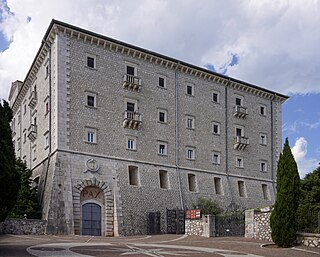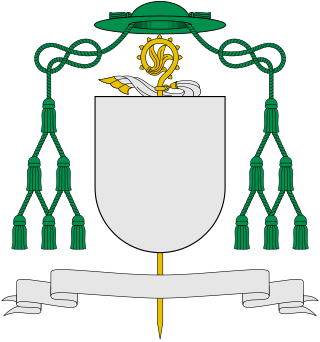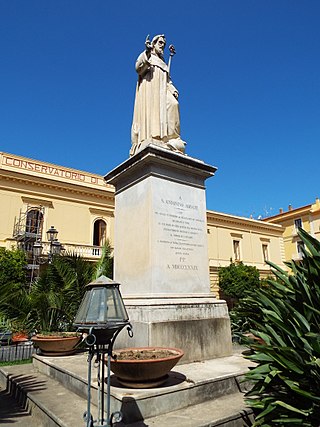
Benedict of Nursia, often known as Saint Benedict, was an Italian Catholic monk. He is famed in the Catholic Church, the Eastern Orthodox Church, the Lutheran Churches, the Anglican Communion, and Old Catholic Churches. In 1964 Pope Paul VI declared Benedict a patron saint of Europe.

Pope Victor III, was the head of the Catholic Church and ruler of the Papal States from 24 May 1086 to his death. He was the successor of Pope Gregory VII, yet his pontificate is far less notable than his time as Desiderius, the great abbot of Monte Cassino.

The Battle of Monte Cassino, also known as the Battle for Rome, was a series of four military assaults by the Allies against German forces in Italy during the Italian Campaign of World War II. The objective was to break through the Winter Line and facilitate an advance towards Rome.

Monte Cassino is a rocky hill about 130 kilometres (80 mi) southeast of Rome, in the Latin Valley, Italy, 2 kilometres west of Cassino and at an elevation of 520 m (1,710 ft). Site of the Roman town of Casinum, it is widely known for its abbey, the first house of the Benedictine Order, having been established by Benedict of Nursia himself around 529. It was for the community of Monte Cassino that the Rule of Saint Benedict was composed.

Odo of Cluny was the second abbot of Cluny.

Cassino is a comune in the province of Frosinone, Southern Italy, at the southern end of the region of Lazio, the last city of the Latin Valley.

The Benedictine Confederation of the Order of Saint Benedict is the international governing body of the Order of Saint Benedict.

Maurus (512–584) was the first disciple of Benedict of Nursia. He is mentioned in Gregory the Great's biography of the latter as the first oblate, offered to the monastery by his noble Roman parents as a young boy to be brought up in the monastic life.

A territorial abbey is a particular church of the Catholic Church comprising defined territory which is not part of a diocese but surrounds an abbey or monastery whose abbot or superior functions as ordinary for all Catholics and parishes in the territory. Such an abbot is called a territorial abbot or abbot nullius diœceseos. A territorial abbot thus differs from an ordinary abbot, who exercises authority only within the monastery's walls or to monks or canons who have taken their vows there. A territorial abbot is equivalent to a diocesan bishop in Catholic canon law.
Saint Petronax of Monte Cassino, called "The Second Founder of Monte Cassino", was an Italian monk and abbot who rebuilt and repopulated the monastery of Monte Cassino, which had been destroyed by the invading Lombards in the late sixth century.

Antoninus of Sorrento was an Italian abbot, hermit, and saint.

Winibald was abbot of the Benedictine double monastery of Heidenheim am Hahnenkamm. Traditionally, he is called the brother of Willibald and Walpurga.

Saint Gerald of Sauve-Majeure, OSB, also known, from his place of origin, as Gerald of Corbie, was a Benedictine abbot.

San Vincenzo al Volturno is a historic Benedictine monastery located in the territories of the Comunes of Castel San Vincenzo and Rocchetta a Volturno, in the Province of Isernia, near the source of the river Volturno in Italy. The current monastery, housing a group of eight Benedictine nuns, is located to the east of the river, while the archaeological monastery of the early Middle Ages was located on the west.

Michelangelo Celesia, O.S.B. Cas. was an Italian Benedictine monk who served as the Archbishop of Palermo from 1871 until his death, and was elevated to the cardinalate in 1884.
Bonit or Bonitus may refer to:
Bertharius was a Benedictine abbot of Monte Cassino who is venerated as a saint and martyr. He was also a poet and a writer. A member of the Lombard nobility, Bertharius as a young man made a pilgrimage to Monte Cassino at the time of the abbacy of Bassacius and decided as a result to become a monk.

The Abbey of Santa Maria a Mare was a monastery on the island of San Nicola in the Tremiti Islands off the northern coast of the Gargano Peninsula in Italy from the 9th century until 1782.
Mummolus was the second abbot of Fleury Abbey at Saint-Benoît-sur-Loire for 30 years between September 632 and January 663.

Monte Cassino Territorial Abbey or Monte Cassino Archicoenobium is a territorial abbey in Italy and a see of the Roman Catholic Church immediately subject, which belongs to the Ecclesiastical Region of Latium. As of 2016, there were 13 inhabitants, all baptized. The seat is governed by the Right Reverend Abbot Donatus Ogliari O.S.B.















